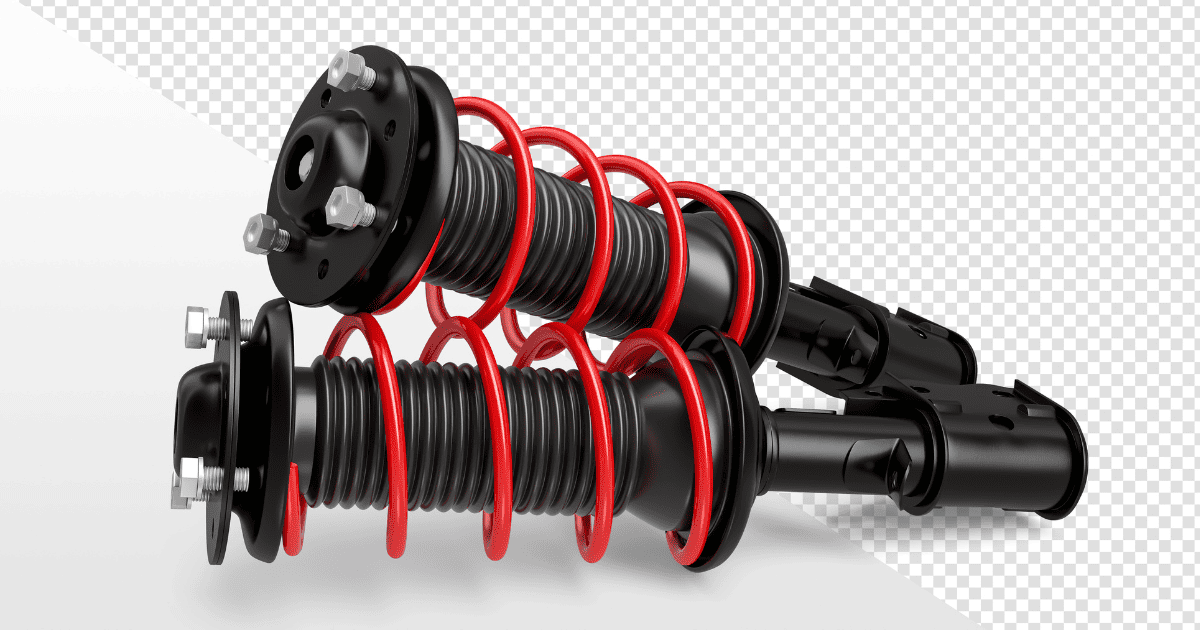Coil springs are metal components that play a crucial role in a car’s suspension system. Made from metal wires that are wound tightly into a coil shape, these springs are designed to absorb the shocks caused by bumps, dips, and other uneven surfaces on the road. As your car travels over rough terrain, the coil springs work to maintain stability, ensuring a smoother ride. The number of coils and the spring’s ability to handle weight and pressure determine how well the spring performs in absorbing these forces.
When you drive on a bumpy road surface, your wheels move up and down at different speeds due to their connection with the axle. This uneven motion creates an uneven force on the vehicle body, which the coil springs help manage. The springs compress as they absorb the shocks, eventually returning to their natural resting position, which helps keep your car stable while traveling. The overall result is a better handling experience, improved ride quality, and reduced wear and tear on other suspension components. Coil springs are a low-maintenance solution for ensuring that your vehicle runs smoothly without the need for frequent replacement, unlike other more complex parts of the vehicle suspension system.
Understanding Coil Springs

Coil springs are an essential component of your car’s suspension system, providing crucial support, cushioning, and stability. Made of metal wires wound tightly into a coil shape, these metal components are designed to absorb the shocks from bumps and dips on the road. As your car travels over uneven surfaces, the springs help ensure a smooth ride by absorbing the impact. The number of coils in each spring determines how much weight and pressure it can handle, ensuring the suspension system functions properly. These coil springs are vital for making your car stable and comfortable, especially when dealing with challenging road conditions.
Whether you’re driving through rough terrain or navigating a smooth highway, the coil springs ensure your car stays balanced and maintains its stability. They work by compressing and returning to their original position as they absorb the shocks, keeping your car steady while traveling. Without them, the ride would be bumpy, and the vehicle would struggle to handle uneven surfaces effectively.
How Do Coil Springs Work?
When you drive on a bumpy road surface, your wheels move up and down at different speeds due to their connection with the axle. This creates an uneven force on the vehicle body, which the coil springs are designed to handle. As the wheel reacts to the bumps in the road, the spring compresses, absorbing the impact and returning to its natural resting position. This process helps maintain a stable ride, even when traveling through rough terrain. The coil springs ensure that your car stays balanced, offering comfort by managing the shocks caused by uneven surfaces.
What Are the Benefits of Coil Springs?
Coil springs in cars provide several benefits that directly improve the overall driving experience. They improve ride quality by absorbing shocks and vibrations from the road, ensuring a smooth and comfortable journey. Additionally, they help reduce wear and tear on other suspension components, leading to a longer-lasting suspension system. The result is better handling characteristics, making your vehicle more stable and responsive, especially when driving over uneven surfaces.
One of the major advantages of coil springs is that they are low-maintenance. These components are built to last and generally don’t require frequent replacement, unlike other parts in the vehicle suspension system. This makes them a reliable and cost-effective solution for maintaining your car’s performance without the need for constant repairs or replacements.
Types of Coil Springs
There are two main types of coil springs:
- Constant Rate Coil Springs
- Variable Rate Coil Springs
Constant Rate Coil Springs
Constant rate coil springs are also known as linear rate springs. These springs have evenly spaced coils that create a uniform rate of compression. As the spring compresses, the amount of compression is proportional to the load placed on it, ensuring a steady response regardless of the weight. Constant rate springs are popular in heavy-duty and performance applications because they provide reliable and predictable performance. When the correct constant rate spring is selected for the vehicle, it can significantly improve ride quality by reducing pitch and roll, making the vehicle feel more stable, especially during sharp turns or bumpy roads. This makes them a great choice for vehicles that require consistent handling and support.
Variable Rate Coil Springs
Variable rate coil springs, also known as progressive rate springs, feature coils that are not evenly spaced. As the spring is compressed, the spring rate changes dynamically, offering different spring rates based on the compression level. The coils that are spread apart provide a comfortable ride under normal conditions, but as the vehicle becomes loaded, those coils compress further, providing additional support. The tighter wound coils prevent the vehicle from sagging excessively, ensuring better stability. These springs are ideal for multipurpose vehicles like daily drivers or vehicles used for hardworking activities such as towing or hauling loads. Variable rate coil springs help reduce harshness, minimize pitch and roll, and avoid bottoming out under various levels of load conditions, making them a versatile choice for maintaining comfort and performance across different situations.
What Goes into a Quality Coil Spring?
A quality coil spring has a direct effect on the ride profile of your vehicle, and several important factors contribute to how well a coil spring performs. The number of coils, the material used, and the coating are all critical in determining its strength and durability. Additionally, the wire diameter plays a key role in how much weight the spring can handle and how it will react under different loads. Each of these aspects needs to be carefully considered to ensure that the coil spring can perform optimally, providing both comfort and stability for the vehicle.
About Spring Rate
Spring rate is a measure of a spring’s strength and is affected by several factors like wire diameter, the number of coils, and the quality of the steel used. It tells you how much weight is required to compress a coil spring by one inch. The OE spring rate may differ depending on the vehicle model, engine size, drivetrain (4W or front-wheel), and transmission type (automatic or manual). These vehicle attributes affect the overall vehicle weight and ride profiles. Even within a single model, different packages and trim levels can alter the spring rate. It’s crucial to match the OE spec for the spring design in order to restore the correct OE ride height. If the ride height is even slightly reduced, the vehicle may start to sag, affecting wheel alignment and causing accelerated tire wear.
Warning Signs of Weak or Damaged Coil Springs
Over time, your coil springs can wear out, especially if you frequently drive on rough road conditions or have a high-mileage vehicle. These springs are built to last, but they do take a toll with age. If your car rides lower on one side, or you notice a sagging spring, that’s a clear sign something’s wrong. A broken spring can cause an issue where the vehicle develops a permanent slouch or has an uneven ride height. When a car leans excessively taking turns, weak springs are often the culprit.
A rougher drive, dramatic bouncing, or feeling every crack in the pavement means the suspension issues are getting worse. Failing coil springs also make the car lose strength in absorbing shocks, leading to noticeable vibrations, bumps, and even uneven tire wear on the outside edges. If worn springs are ignored, they can’t hold up the vehicle properly, leading to premature tire wear and costly replacements. It’s best to take action early and get the signs checked by an auto technician to save trouble, money later and fix the problem before it gets worse. While checking your suspension, it’s also a good habit to ensure other essential car functions, like the recirculate button, are working correctly to maintain optimal driving comfort.
Why is Regular Coil Spring Maintenance Important?
Maintaining your coil springs is essential for a smooth and safe ride, as it directly affects how your car operates. If springs are worn, it can compromise handling and stability, making driving risky. A spring failure while driving could cause you to lose control of your vehicle, leading to accidents or injuries. To avoid this danger, it’s crucial to monitor the suspension system regularly. Properly maintained springs help improve performance, ensuring better handling, braking, and reduced tire wear. Keeping your coil springs in great shape allows your car to handle more efficiently, making daily drives smoother and more reliable. While replacing coil springs may seem like an investment, neglecting damaged ones could lead to more expensive, pricier repairs in the future, so keeping them in good condition can ultimately save money.
How Do You Choose the Right Coil Springs?
Choosing the right coil springs for your car is more than just a quick trip down the parts aisle—it’s about finding the perfect pair for your vehicle. Think of it like picking the right pair of shoes: fit, comfort, and durability matter. If you choose the wrong springs, you might end up with an uncomfortable ride. Start by figuring out the type of ride you want, as your vehicle type will determine the kind of springs it needs. If you’re driving a sports car, stiffer springs might be your best friend, helping you handle sharp turns with precision. On the other hand, a family sedan will benefit from softer springs for a smooth and easy ride. Don’t fall for a one-size-fits-all option; your car deserves better. When choosing between OEM springs and aftermarket options, consider the perks of each. OEM springs maintain the factory-intended performance, while aftermarket springs could give your car a performance boost at a lower cost. However, don’t skimp on quality—choosing the right spring is key to ensuring a safe, smooth drive.
Conclusion
Coil springs are an essential component of your car’s suspension system, playing a crucial role in absorbing the shocks from bumps, dips, and other imperfections on the road. They help maintain stability as your vehicle travels over uneven surfaces. By doing so, they improve ride quality and reduce wear and tear on other suspension components. Regular maintenance and timely replacement of your coil springs are vital to ensuring your car remains safe, performs optimally, and provides a comfortable ride for you and your passengers.
